Topiary meadow and sunken pond garden at Great Dixter, part 2
In part 1 of my recap of my tour of Great Dixter in England earlier this summer, I confessed that I didn’t like the overplanted, claustrophobic feeling of the Peacock Garden and surrounding hedged gardens. But I found breathing room and the longer views I’d craved along the more traditionally designed Long Border, shown here. A wide stone path and mown lawn along one side provided much-needed space to actually see the plantings.
I also enjoyed the view of the old house and its massive brick chimneys across the sunny border.
Splashes of bright red made a vibrant appearance throughout the border’s length. Here red roses and poppies pal up with the pink and brown flowers and chartreuse foliage of spirea (perhaps ‘Magic Carpet’?).
Cream and gold variegated foliage looks great with red…
…as does nearly black sambucus foliage.
More darkness in the center of these violet flowers.
The overplanted feeling of a jungle returned in the Exotic Garden just below the house. Bananas, palms, and other bold-foliage plants leaned overhead and jammed against the walks with no visual relief. Again, it was too much of a good thing for my taste.
At last, under a tile-roofed loggia on an elevated terrace, I found the open space I craved.
The loggia overlooks a sunlit meadow, dotted by smoke trees in gauzy bloom and quirky topiaries — fun and original!
I loved the simplicity and architectural boldness of this garden, known as the Topiary Lawn, as well as the contrast between the artificial, clipped evergreen shrubs and the loose naturalism of the smoke trees and fine-textured meadow.
Along one side, stone-wall terracing provides another overlook and was blowsy with flowering perennials.
Jupiter’s beard had seeded itself into the stone wall…
…and was charming in rosy bloom.
From here stone steps lead up through doorways of clipped shrubs.
A neat lawn surrounded by a lovely mixed border of perennials and shrubs is “guarded” by mustard pot topiaries.
A closer look at the mustard pot topiaries. (Does anyone actually use a mustard pot? I’m not that civilized.)
I can’t remember where I spotted these house leeks (aka sempervivum) growing on a tiled roof, but aren’t they a fun surprise?
Stepping into the Wall Garden you’re greeted by a blazingly colorful containerized flower garden in shades of pink, purple, orange, and chartreuse, backed by tall grasses, shrubs, and trees (possibly all containerized too).
It’s a flower party, and you’re invited.
A low pot of succulents adorns the front of the arrangement.
If you can tear yourself away and enter an arched doorway in the brick wall…
…you overlook a sunken pond garden, blowsy in midsummer bloom, anchored by an octagonal pond.
This garden is perhaps as densely planted as the Peacock Garden, but the high view affords an opportunity to gauge the entire scene, which I appreciated.
Two old barns form “walls” along two sides of the garden, including the Great Barn, pictured here. The funny-chimneyed oast house, used for drying hops, runs alongside the barn.
This flowery upper path runs toward the White Barn. The old farm buildings and main house at Dixter add much ambience to the gardens, as well as enclosure.
Poppies in bloom in mid-June
Silver dollar plant, if I have the name right. I’m always attracted to the beautiful, translucent seedpods of this plant.
Opposite the Great Barn, a tall hedge with a notched doorway makes a third enclosing wall. An open doorway beckons…
…with a view to a semi-wild meadow — Great Dixter’s nontraditional front yard.
Enclosing the meadow, zigzagging hedges that look a bit lumpy and quirky, like a child’s toy train set or building blocks shoved together, suggest that a surprising garden lies ahead. As indeed it does.
For a look back at Part 1 of my visit to Great Dixter — and some surprising areas that I didn’t appreciate — click here. Coming up next: My last post about our travels through England, a near-solstice visit to Stonehenge.
I welcome your comments; please scroll to the end of this post to leave one. If you’re reading this in a subscription email, click here to visit Digging and find the comment box at the end of each post.
_______________________
Digging Deeper: News and Upcoming Events
Join the mailing list for Garden Spark Talks! Inspired by the idea of house concerts, I’m hosting a series of garden talks by inspiring designers and authors out of my home. Talks are limited-attendance events and generally sell out within just a few days, so join the Garden Spark email list for early notifications. Simply click this link and ask to be added.
All material © 2006-2018 by Pam Penick for Digging. Unauthorized reproduction prohibited.


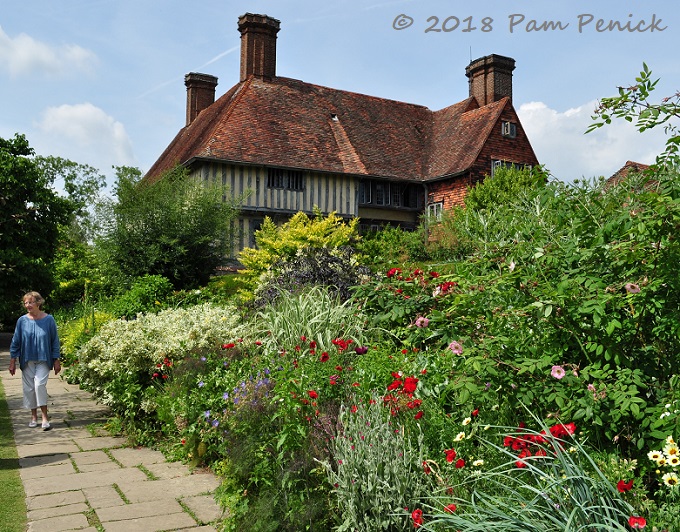
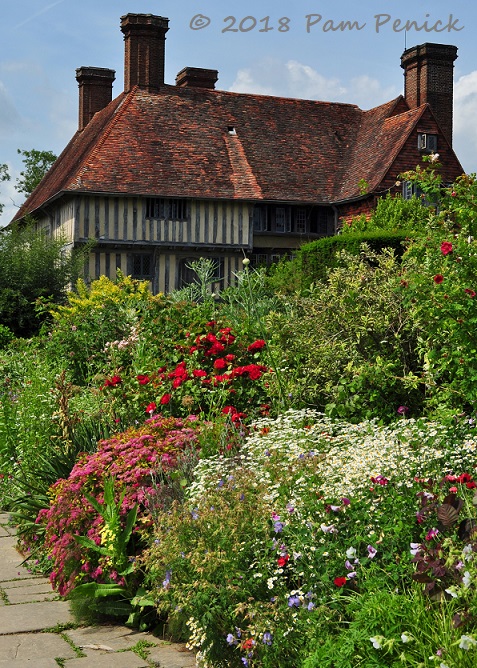
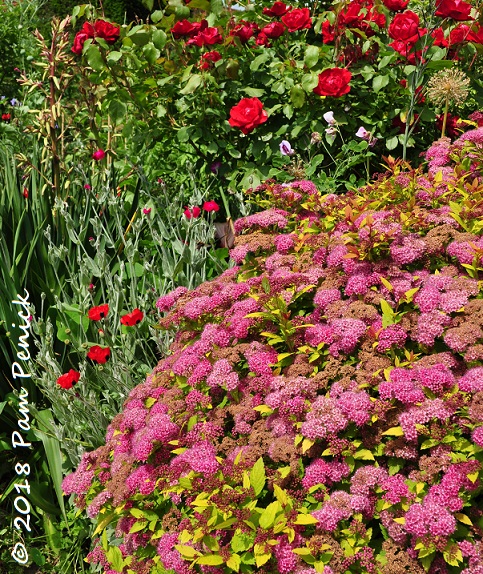
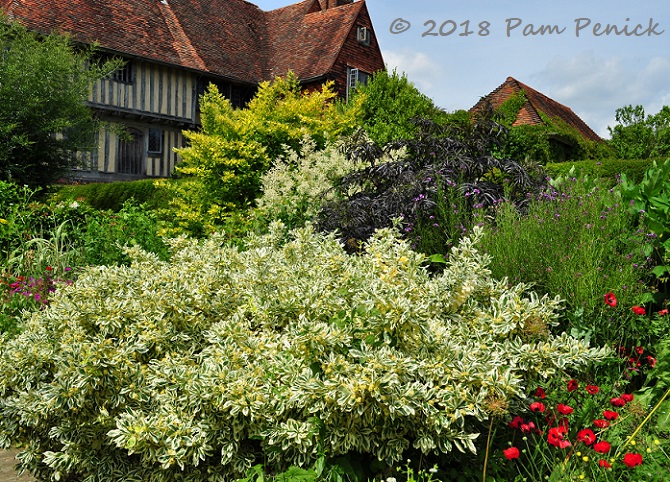
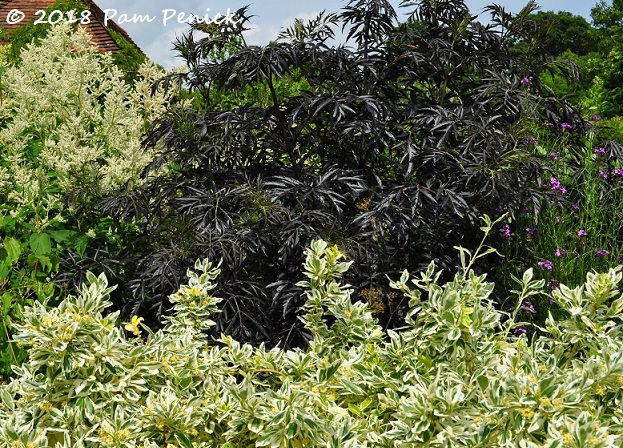
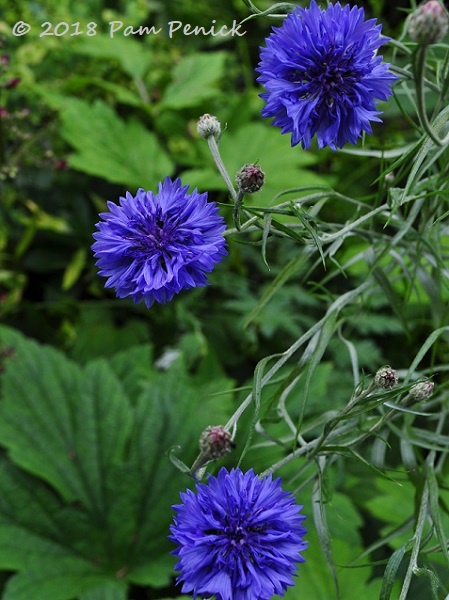
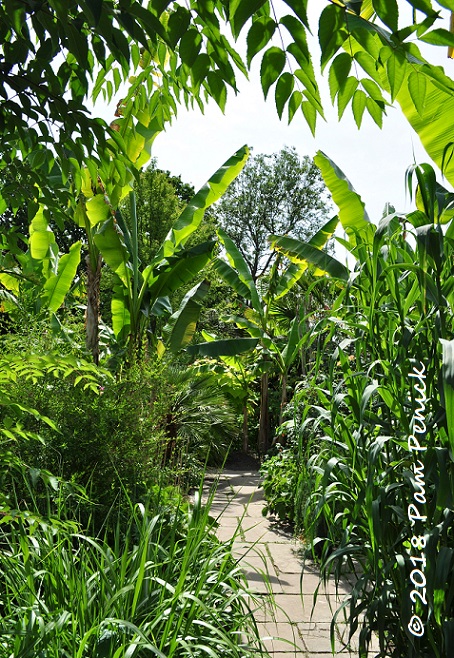
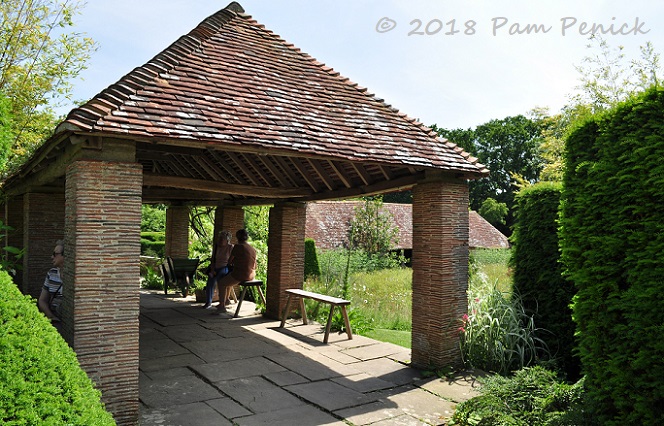
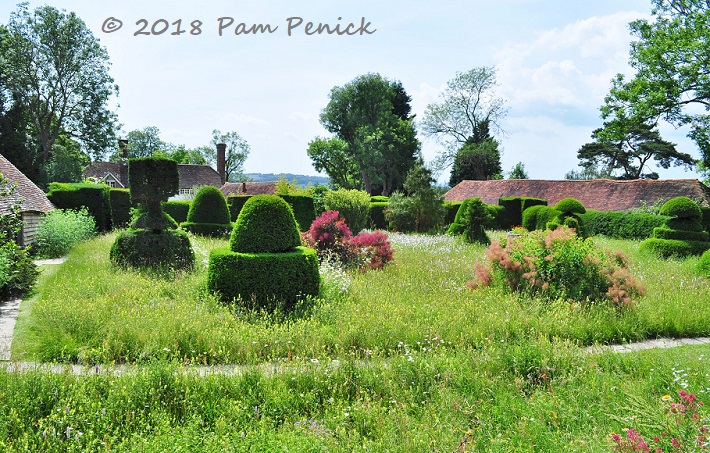
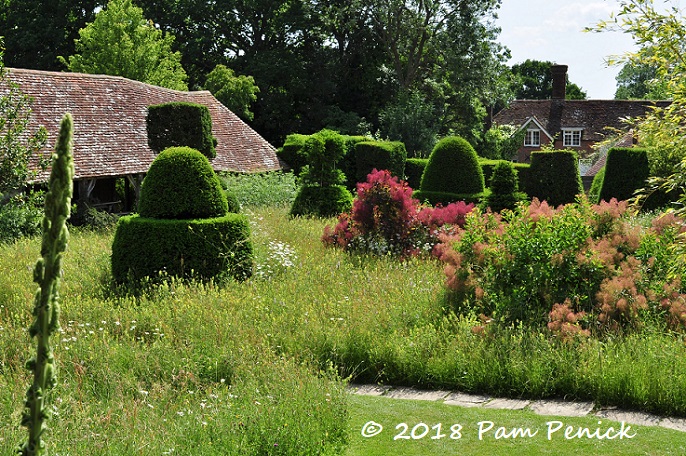
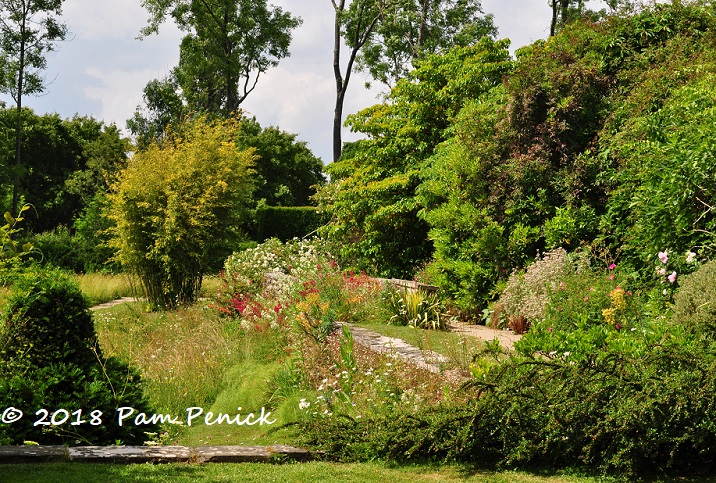
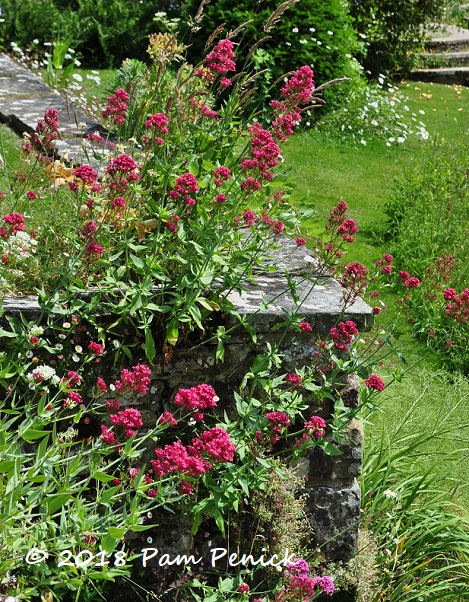
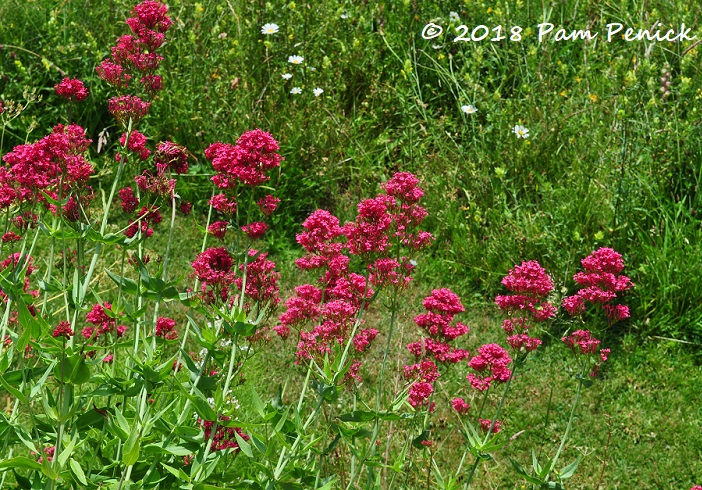
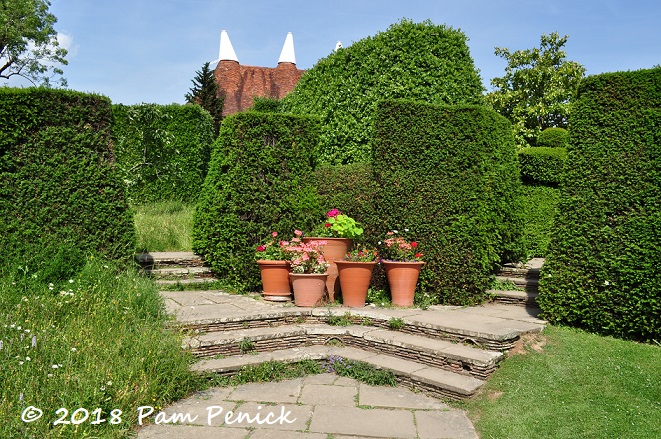
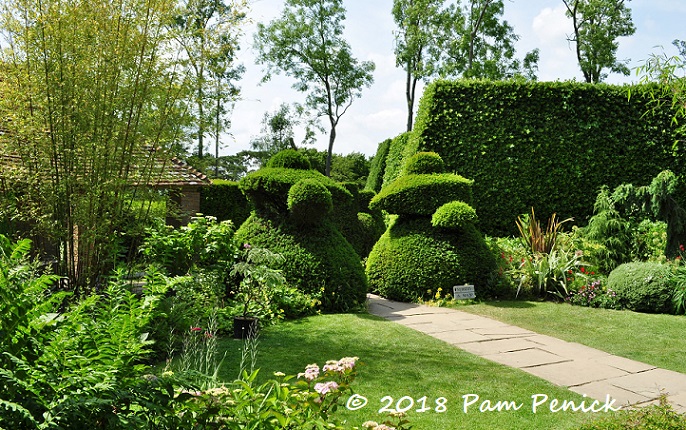
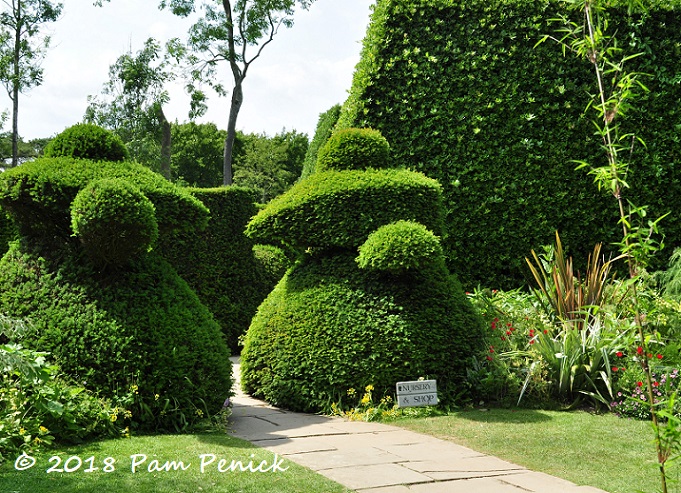
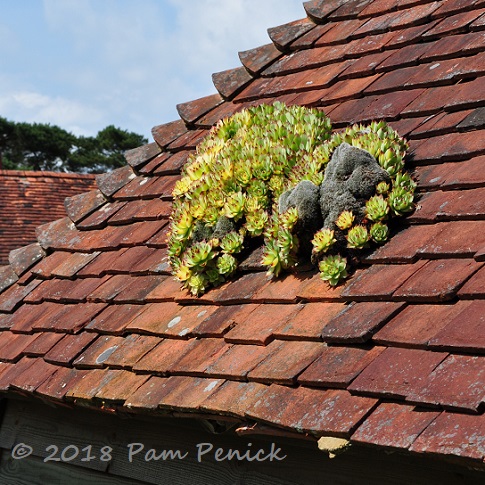
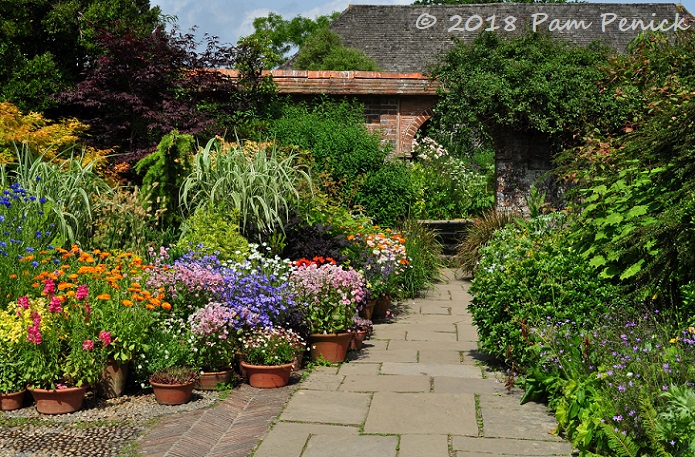
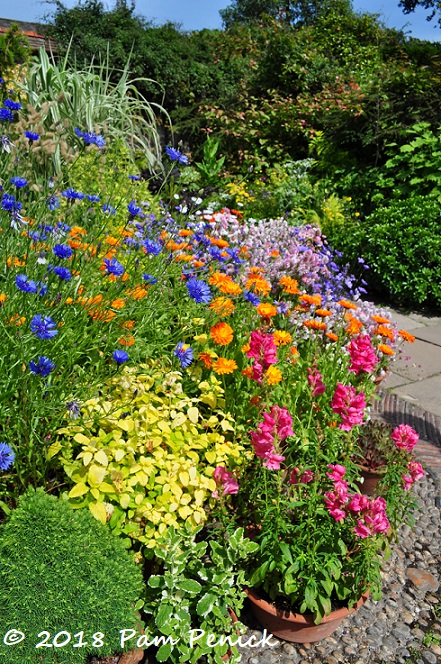
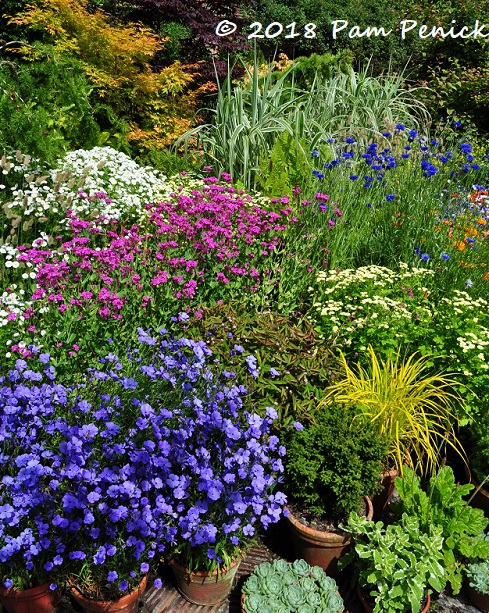
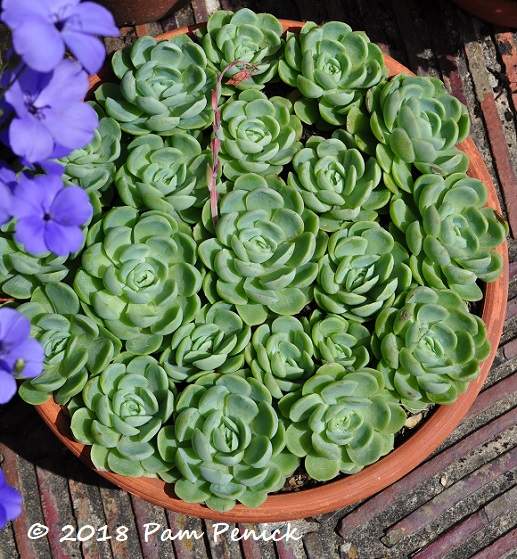
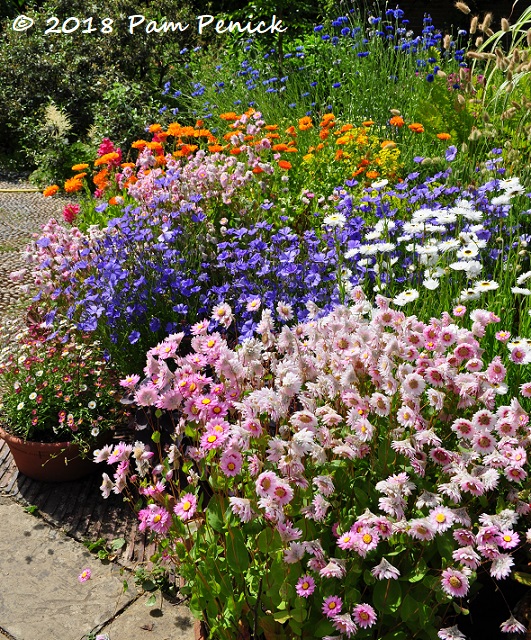
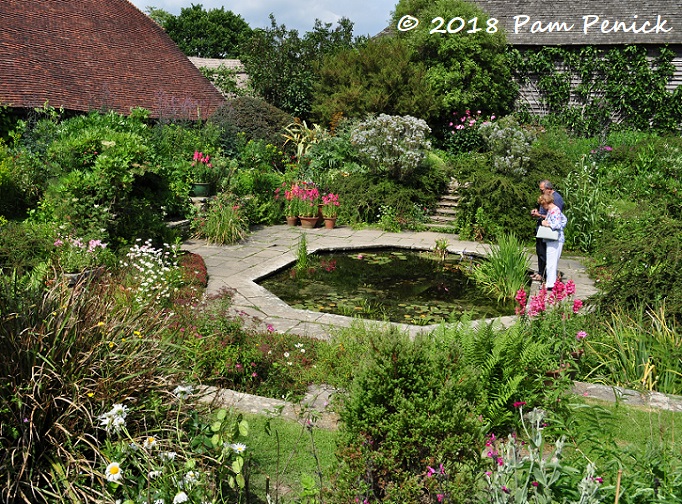
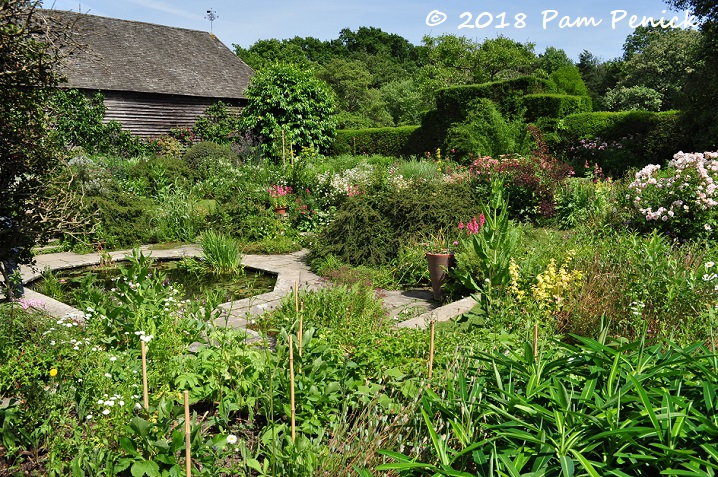
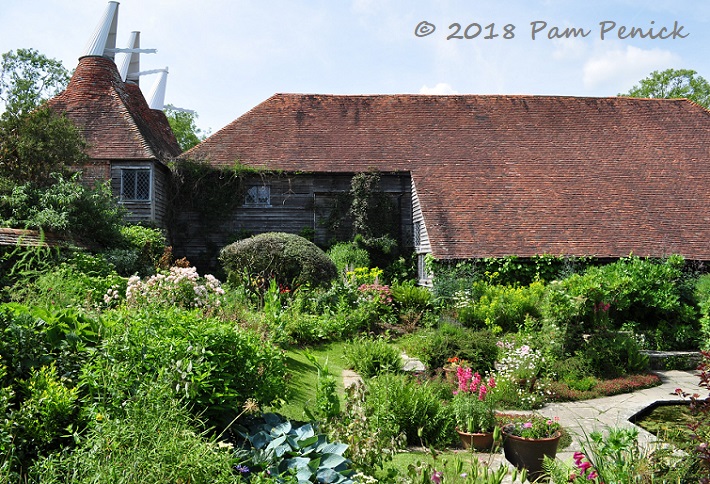
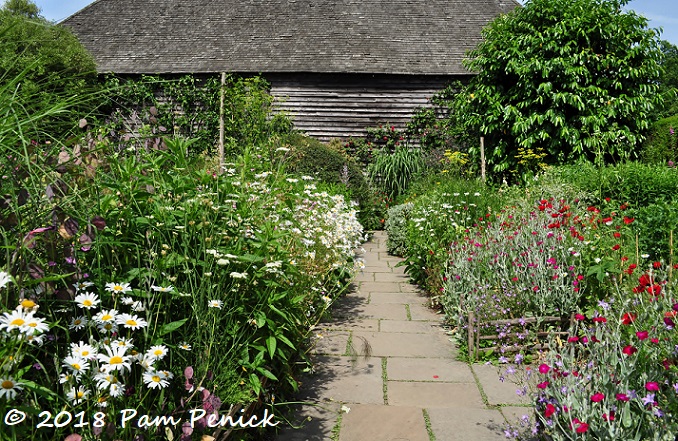
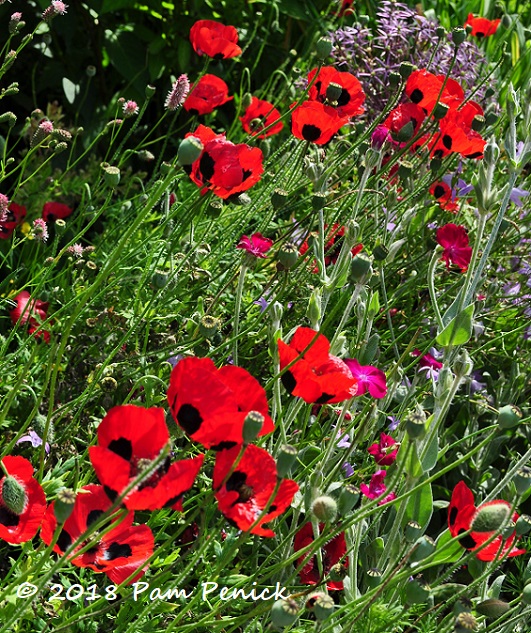
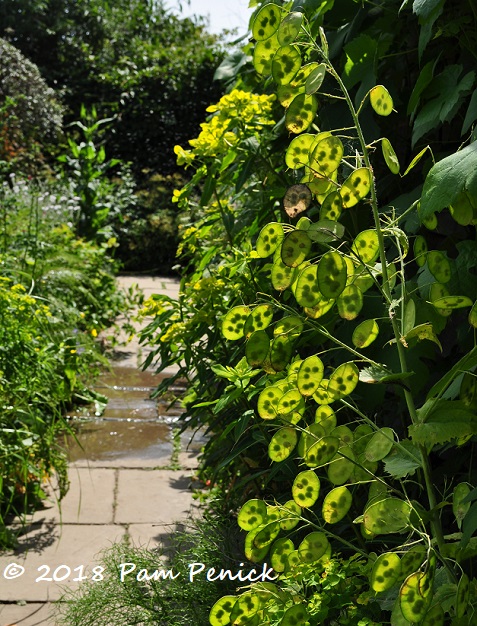
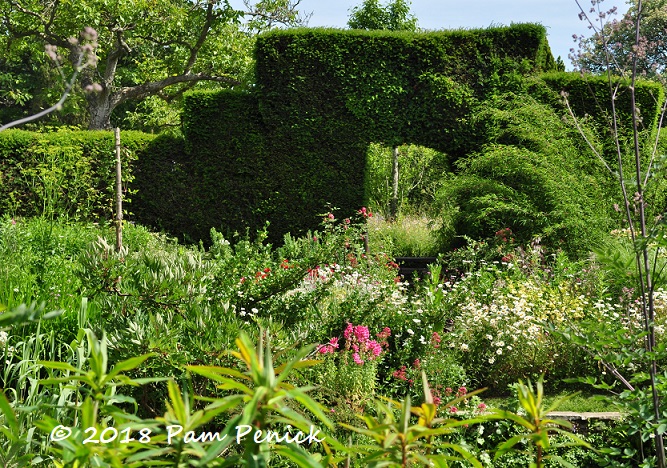
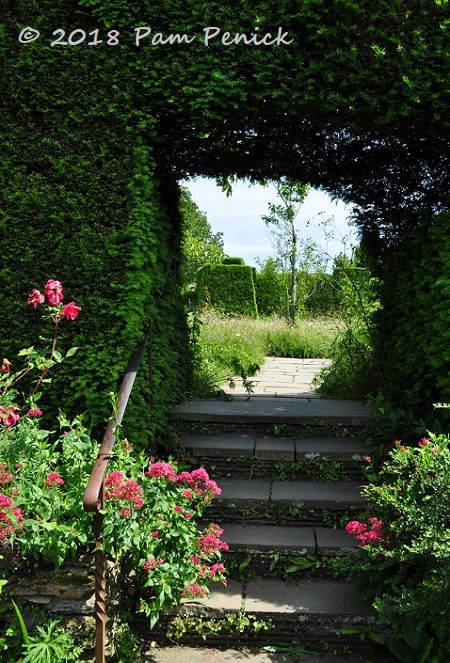
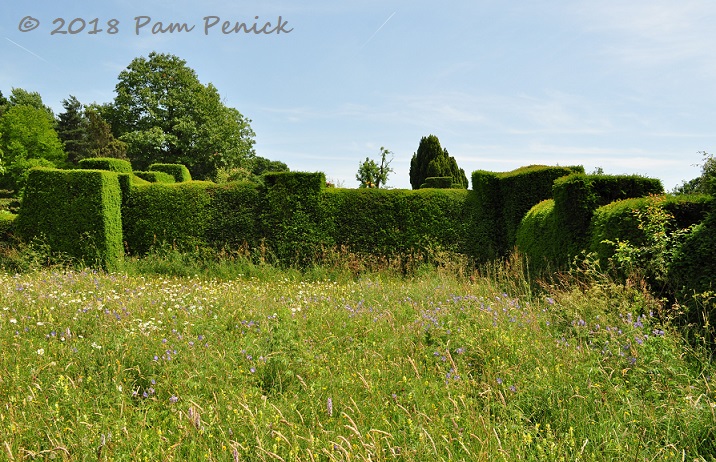
The topiaries are fun and quirky, and I like the meadow. I’ve never quite “gotten” topiaries that are just shaped into cones or balls, but I love the mustard pots. I can see why you liked the more open spaces here better.
I never got topiaries either until I saw how James David contrasted clipped balls with spiny agaves and wilder plants in his Austin garden. And then suddenly I LOVED them. Here’s a link: https://www.penick.net/digging/?p=33188
Lloyd did throw all the guidance on color combinations out the window – or, perhaps more accurately, into the faces of his critics. His willingness to combine any and all colors is on display in your photos. I love that black Sambucus – if only I could grow it! (Even Leucadendron ‘Ebony’ doesn’t come close.) The Sempervivums on the roof made me laugh.
The Exotic Garden’s jungle look didn’t create the same sense of claustrophobia I felt in connection with the scenes shown in your earlier post, perhaps because that central path provided a clear line of sight on which to focus. Or maybe it just reminded me of my tiny but beloved former garden, which some people called a jungle. That in turn brought to mind a story I remember from my undergrad days as a student of cultural anthropology about people living in jungles seeing things differently from people living in grassland environments because their eyes were attuned to different focal points. Maybe a similar factor plays into how people perceive landscaped gardens.
I do wonder if the Texas aesthetic of more-open spaces played into my feelings about this garden. But actually Austin can get pretty jungly in summer, and it drives me nuts then too. I think it’s just me!
It must be nice to live on a plot of land that is big enough to have yews as fences/dividers. It is a fun thing to me to have them grow large enough to topiary into what ever shape one may think up. I love the doorways. The steps up to yews that split the walk is a fabulous way to make one think ‘which way do I want to go’. All of those pots gathered together with so much color is a blast too. I really like the surprise of the semps on the roof. I love tile roofs. I think they have such character. There are a few old homes in my city that have them still. A fun tour here despite your apprehension of the crowded walkways.
I enjoyed the yew hedges too, Lisa. Anytime there’s a doorway and a view through it I have to go explore.
Beautiful documentation, Pam!
Thanks, Denise. 🙂
That low meadow with topiaries and smokebush is captivating, but also instructive: Having always grown Cotinus as a cut-back shrub (a dark splodge to back and set off creamy-white daylilies), I’d never realized that different varieties would have different colors of “smoke”. Now tempted to let a few shoots of ‘Velvet Cloak’ go next season to see if the flowers are anything like that beautiful deep rosy one in the photo. (Suspect that a paler, more washy pink is more likely, though.)
You don’t grow them for the “smoke,” Nell, only for the foliage? It does sound like an experiment is called for. 🙂 I agree that the wine-colored flowers are stunning.
The plant you call Silver Dollar Plant is typically called Honesty in the UK 🙂
I always enjoy common names. I wonder how it got that one?
Hello Pam,
These posts (both parts 1 and 2) are just fantastic! I really appreciate getting to “hear” your thoughts on it, especially from a design perspective (something I don’t really have any background in), and in the context of your England garden tour. It’s so amazing to be able to compare your pictures/visit with mine, just a few weeks later. It’s really intersting how different colors and foliage come out — maybe its the light, or maybe just that different things were in bloom when you were there. The front meadow was pretty much done by the time I visited, so its a treat to see your photos.
And though, yes, I’ve been gushing about GD, I do in fact agree with your take on the Peacock Garden and surrounding Gardens. I found those gardens to be like some wild experiement of a crazy flower obsessed gardener — or a mad scientist, and in all its out-of-control-ness it felt sort of private, like, not something truly meant for public eyes. Yes I found it charming, but like you’ve said everyone just differs in their reactions to things. I also explored these parts of the garden last: I started with the formal sections that you like the best. That’s making me think a little about how starting with something ordered and accessible just makes for a better experience, in so many ways (whether its writing, a piece of music, or a garden).
Anyway — just my thoughts. But thank you again for these great posts! It’s been so much fun to learn about all the gardens you visited on your trip.
Amy
Thanks for your comment, Amy. I’ve really enjoyed your posts about Great Dixter, and yes, I bet the order in which one tours a garden impacts how one experiences it. Interesting thought! I hope to visit again one day.
Thank you for the tour. Your descriptions of the spaces in a garden are always so helpful.
Must have been a gardener’s wildest dream of a vacation.
I have a clipped Myrtus nestled into wilder plants, but it doesn’t make such a glorious impact. It takes a virtuoso.
I was thinking of trying a few clipped Myrtus amid grasses this fall myself, HB. It’s interesting to hear that you don’t find the impact quite what you’d hoped. But still, we have to work with the plants that want to live in our hot and dry climates, don’t we?